In my surviving memory, I've flown Air India three times. And the third time, today, I wasn't any more lucky than the last two. However, on each of these occasions I have had just a little more dose of good luck than before, for which I have no one but myself to thank. Read on and pray you tell me why I should do otherwise...
The first occasion was a flight from Goa to Chennai: I was returning from a week long vacation with my wife. The flight, scheduled to start at something like 8 am - making us leave from our wonderful home stay, couple of hours drive away, at a less than preferable hour of 5:00 am, only to find that the flight has been delayed by a mere 6 hours. Oh, if you are thinking that was barely inconvenient, I'll have you know that it's never as silly as that with Air India. They don't bestow their kindness too easy. Here is the sequence of events:
1. We land at the airport at 6:30 am to see an indefinite delay sign.
2. Look for assistance, and well, it was obviously early in the morning to get any of that. 3. Have coffee, catch a bite. Catch a nap, which still didn't cure the growing unease when the clock edged fairly close to the take-off time, and yet no news of the new departure time or of any staff!!
4. Its half hour to take off and I was beginning to be just a tad bit unsure if I landed at the right airport/right day.
5. Both clarified with ease, we find our meandering way to the first sight of an Air India staff.
Now, and only now...
6. We got the good news easy. Admittedly no more tarry. And even after that things moved fast - towards a cheap hotel (incidentally AI still didn't make a public announcement of the delay and that they were ushering away the passengers to a hotel to rest).
7. Whoever had the foresight to seek out the staff were herded out.
So, Goa ended with fond memories and a minor note to avoid Air India. A note so minor, it was soon forgotten.
So there was a second occasion. Not returning from a relaxing vacation to be surprised by a wonderful delay, this time. Worry not, for we are yet in for something special. The Air India flight was to take me, on Sunday evening 6pm, from Chennai to Mumbai, so that I could join my new job - with the world's more profitable financial company, which for some weird reason expects its new employees to to be punctual, on a Monday morning. I arrive at the airport at 5pm a good hour before the departure, which some may say is generous for a domestic flight, and happily found my way around the new, and isolated, sprawling airport Chennai has recently opened. After lugging around a fair bit of luggage towards the Air India's entry gate ( I was relocating cities to join my new job), I was promptly informed by the smiling guard that my flight is waiting in the International terminal. Did I say that my ticket makes no mention of this inconvenient fact? In fact it says, Air India "may operate" in international terminal only in Mumbai and Delhi. So, bad luck, if you happened to read the fine print. If you didn't, well still bad luck, maybe less so for you are the kind who actually bothers to ensure you reach the right airport, you might also have planned the arrival time well. Now, the complications get extremely interesting.
Not only was the international terminal nowhere close to the domestic, there is absolutely no transportation between the two places. Nevertheless, I ran (the best I could with 30 kgs in row) and tried to flag down every passing vehicle, hoping that I can make it in the next 20 minutes (40 mins is the minimum time to reach check-in for a domestic flight). And miraculously, I managed to hail a cab who generously agreed to take me to the international terminal for a mere Rs.500, and cover the 2 kilometers in 10 mins. To his credit, he did.
I reach the Air India counter a bit out of breath but happy, only to see no sign of people or of any announcement on what flight they were currently boarding. Nonplussed, I tried to attract the attention of a small group of staff sitting away from the counter and enjoying a mild banter, and ask them if they knew anything about this flight number that I was supposed to board. Mildly surprised, one of them half-amused says,
Bantering staff: Sir, that flight has already left.
Me: What?
Bantering staff: Well, it has not left yet, but the check-in is closed.
Me: but there is still 45 mins left.
Bantering staff: But the counter closes 1 hour before take-off
Me: Why? Isn't this a domestic flight
Bantering staff: No, its an international flight
Me: What? I am flying Chennai to Mumbai. How is that international?
Bantering staff: After Mumbai the flight goes to Dubai
Me: <Blank expression>
Me: So what can be done?
Bantering staff: Nothing
Me: How do you mean nothing. Can you book me on another flight?
Bantering staff: Nope. There is no other flight
Me:Ok. Can you talk to the chief of staff. The flight hasn't yet boarded. I am here and there is still (now 45 mins) good time left.
Bantering staff: No nothing can be done
Me: Can you talk to someone at least?
Then he vanishes into the office for a few seconds. I am soon joined by three other people who, like me, have had to do a treasure hunt to find this counter after going to wrong terminals.
We <in chorus>: so what can be done?
Bantering staff: Nothing sir. The manager says the flight is boarded.
The conversation goes through a whole cycle again, wherein each of the aggrieved party tries to reason with this attendant. Cutting to the final bits of the conversation
We: Ok, so you can't board us. You can't give us a different ticket. How about a refund.
Bantering staff: Contact the call center.
We: The number please?
Bantering staff: Its closed now. Will re-open Monday morning
At our wits end the bunch resigns ourselves to the fate. Make a beeline for the reservation counter of a different airline in a different terminal, while wondering why we chose to fly Air India. In this pensive
state while trying to exit the terminal the security force stops us and says we can't leave. Now what? We can't fly and we can't leave. The smirking guard says, "why do you guys insist on flying with Air India"… and then says,
its not that we can't leave. We can, if the flight attendant signs a register. Now back we go running to the "Bantering staff" who conveniently saved this piece of information from us. Slowly we shuffle out, buy another ticket and kiss our 8-9000 rupees good bye. ANd I readied myself to explain to my new employer, why I can't reach office on my first day, till noon.
Now, what we decide as a group seldom gets done when we are alone. So, cut to today, I choose to fly Air India again! (I told you, its me, and just me who should be given credits for the wonderful fortune)
But today's flight began better. They called me yesterday night to let me know that I should reach the airport 2 hours before the flight (scheduled for 11 am) - and thanks to my past experience, I dutifully obeyed. Better still, I thought I will play it safer - checked in online, and didn't carry a check-in luggage. So when I reached the international terminal (I got that right too this time, despite the e-ticket saying nothing of the kind) at a little past 9, I was very hopeful to clear security in the next 15 mins and catch a nap. So I was fairly unprepared for the first surprise - I tried to be smart, as the Air India's website advertised, and just collect the boarding pass fast, for I had no reason to wait in the check-in queue, or do I? That's what this lady at the counter deemed. She just looked at me, and said "Queue" - my attempts at explaining how that might be unnecessary since I have already done the check-in, and don't have a baggage, were quickly cut short with a derisive snort meaning I am wasting her precious time. So, of I went behind the half hour long queue - there were just two counters open, with no sight of any other personnel from Air India
Half hour later, when I finally got my turn to print the boarding pass, the lady in the other counter asks, most innocently,
Innocent lady: sir you have already checked-in
Me: <with sparkle of acknowledgement in my eyes> Yes!!
Innocent lady: And you don't have anything to check in
Me: <ebullient at the prospect of having met my kindred soul> YES!
Innocent lady: <a vaguely puzzled look>
Me: .. and this wonderful lady in the count next to you, still thought I should stand for half hour to get the pass printed. Isn't this wasting everyone's time?
Innocent lady: Sorry sir,,,
Now, doubly happy, having yet made it to the security with more than an hour to spare for the 11 am flight, and having found a kindred soul, I breezed past the security with a spring in my step, that led me hurtling straight to the only board with a flight schedule in a 2-acre airport. And here is what I see >>
Okay, the flight's delayed to 12:30 from 11am - not too bad. Can do something useful with that 1.5 hours, as soon as I can catch a breakfast. So, a quick saunter across the 2-acre landscape, managed with the still undiminished ebullience, I see there are no restaurants. Well, this can't be flummox the man with a kindred soul, so I walk back to the security and ask if they'd let me out again, so that I can catch something to eat. Surely, thats a reasonable request - I aint saying let me in - just let me out. Happy to be screened again, when I come back. Tut tut! thats not how AAI works - even when presented with a compelling reason of how Air India delayed my flight by 1.5 hours. In fact, all that begot was a (now familiar) scoff, "Why do you fly Air India sir?" - by now, I think I have that voice permanently playing in my head, and it is increasingly taking on a demonic proportion - complete with a echoing, hollow laughter and some boding lyrics like Eagles sang of people going to Hotel California. I was advised to wait for the Air India staff and then appeal to them. Nothing can be done until then. And as to where are the staff and when they'd arrive, the security personnel had no answer other than a hollow laughter.
So, my entreaties to no avail, I settled for a bottle of water and some biscuits from a small outlet, and awaited the hour when the Air India staff would make their appearance. I wasn't to be denied that for long, however. After a half hour I could hear some animated conversation about someone demanding to leave the airport and not come back - something told me the Air India staff had arrived. So off I went - got talking to them. And slowly they relented and used some loophole to get me past the security, back to the check-in area. Once again, I felt all was well with the world, as I dashed off to sate my epicurean needs. I dashed and dashed.. and so were my hopes. For I was soon to realize that Chennai International airport was absolutely unique, in that it does't have a single restaurant! There were a couple of lounges for the various flight alliances, which wouldn't let me in, if I wasn't flying one of their airlines. Air India wasn't part of any - and now I am somehow less uncertain why that might be the case (there is rumor that Air India has been courting the Star Alliance with gusto, which I hope to dear God doesn't go any where). The jugaad in me managed to get an hours waiting time at one of lounges with a kind matre'd and a frequent flyer card. And once again I was beginning to regain my bonhomie for the Air India brethren.
So, close to noon, I decided to find my way back to the security and get ready to board the flight at 12:30. Security cleared and men's room visited I look for some indication on that lone schedule announcement screen for the gate number of the flight am supposed to board. A long hard stare returned a blank, nevertheless. So I waited for a while, sauntered around the 2-acre airport, and came back to the same spot with five minutes to spare for the flight time. Surely, there must be the gate number now. And surely, there wasn't. Well, the eyes sought out for people resembling Air India staff to ask why. And all I could see were a sea of humanity who seem to be lost and mildly agitated. 12:30 came and passed, and I was getting restless as usual, and asked some random strangers if they knew anything off the Mumbai flight and were they traveling in it, by chance. As chance would have it, they all were, like me. And they all were confused, like me - no one had a clue when the flight was to depart. One young man said in completely amusement, that he has in the past ten minutes heard completely confident accounts of how the flight was going to start in 5 minutes to five hours.
Now, the spring in my step lost a tad bit of what makes the springs springy. I felt compelled to find some resting space, recharge my iPad, and make a few calls and somehow distract myself till i get some official to announce of the real scene. Again, I wasn't to wait too long. Soon, there was the refreshing voice of an Air India staff that very apologetically announced that they were very sorry for the delay, which occurred due to "some technical reason", and now the flight was to start at 1330hours. Great - now we have an official time. And the delay was but for 2.5 hours from the original schedule. Not so bad was it.
Not it wasn't.. back then. Soon it would be.
1:30 came and went away, as sure as they always do. And no news of the impending departure. SOon there was another announcement, that some snacks being served. Surely, after the snacks the stewards would be refreshed to fly?
Hope.
Well, tea and snack done, another announcement came, indeed - 1:30pm on the clock - 4.5 hours of wait done and the announcement chimed, that AI 343 is cancelled. Chaos ensued, as its wont to happen. The enraged and the impatient and those who just wished to remind the world of their stentorian voice, pounced on the two Air India personnel. An hour of pummeling them. Now asking they for a reschedule, now for a refund, and sometimes for a connecting flight refund. One person had a bus to catch after reaching Mumbai - and the AI personnel solemnly answered him that the bus was beyond her jurisdiction. Then there were requests for a five-star dinner and stay… a wonderfully insightful time to understand the various things people want when denied a timely travel.
So, here I am having been promised that there would be another flight arranged for us at 1800 hours - and this reminded by the check-in personnel, who looked me in the eye and read out what was on her screen - "See, Its 3:30 pm now. And my system shows your departure time is 1800 hours. If this gets postponed again, don't blame the check-in counter, ok"
No lady. I won't. For I just count myself incredibly lucky and totally take it as my own act of undefeated positivity that makes me come back and book a ticket with Air India!
Was watching a rather interesting talk by the Wikispeed CEO in the SDEC 12: Keynote. So, we might have gotten to being agile, decades after, having taken a page from manufacturing. But surely, the software practices thereafter evolved much faster than its manufacturing counterparts. Now, however, it seems like the manufacturing world should catch up soon . The presentation above talks about a whole lot things. Their process already seems to have embraced a lot of stuff we do, some adapted - - They call it eXtreme Manufacturing (XM)
- Scrum - 7 day
- Cross-functional teams
- Swarming
- Feedback - Showcasing often
- Evolutionary design - starting with ugly&working&frugal products
- Inter-changeable/modularized parts
- TDD! and regression suites
- Promiscuous pairing, even!!
Wonder if it would be an interesting intro to the many non-IT clients we might encounter in the consulting world, I suppose - especially making the non-IT stakeholders see value in some of the practices we espouse? Not sure if these attempts are unique, but the extent to which these guys have adopted seems quite impressive - and then make it work? 100 mpg? 3-hour swarmed assembly? Awesome! Seems like they also presented in Agile 2012 in Dallas - wonder what your takeaways were, if you were there. Here is another, shorter, talk o TED by Joe Justice.
A brief history of Mifos(Etym. Micro Finance Open Source)Started as an initiative of Grameen foundation, supporting more than 850,000 micro finance clients across 25+ micro finance institutions in India, Tunisia, Uganda, Kenya, Mozambique etc. Mifos is a platform built to support institutions that operate in the micro finance world. Grameen formally withdrew direct support in June 2011. Since then it has been supported by COSM, which is a diverse collective of participants building a microfinance movement powered by open source innovation. COSM aims to make microfinance more open and effective by equipping MFIs with software, collaboration tools and a local support network to use technology to reach the poor. MIFOS' mission is to create a world that can have 3 Billion Maries. This motto came about, goes the folklore, when in a visioning exercise for Mifos, wherein everyone shared their mind on how the product should shape up, one of the participant narrated the story of Marie-Claire and how he saw a world with 3 billion Maries (3 Billion being in reference to the number of people said to live on less than $2 a day). COSM is currently in the process of re-architecting the Mifos, and building the next generation Mifos X, in the light of a lot changes - 1. In the Micro Finance's applications (Micro lending becoming more sophisticated. More product innovations to help the poor - savings, insurance 2. In regulations (Better accounting practices, governance and regulatory reporting) 3. In the platform demand - A complete inability to support and extend the current platform to manage the above ThoughtWorks and MifosThoughtWorks has worked on a few projects contributing to the extant platform, since November 2007 (Mainly from New York and Bangalore). We were one of the early contributors, through commercial implementations and contributing to the open source platform. We haven't been contributing to this platform in the past year, after Grameen's departure. Mifos implementors global meetup (Bangalore, Oct 2012) - A diaryThoughtWorks took part in implementing a part of their application as part of the SIP umbrella during the period 2011. MIFOS Summit happened in Bangalore during October 16-18 in which Praveena and Ram took part. The summit was mainly to focus on the current problems the users face and what are the new functionalities they look out for in the new product MIFOS X which is a complete rewrite of their existing product. Day 1 (Oct 16 - Visioning)Highlights of MifosX wishlist - New products (Savings, Insurance) and flexible micro lending products (Variable schedule, interest rates, Group loans with multiple collaterals/schedules etc)
- Accounting modules or ability to add on Accounting products
- The mobile implementation was much sought after since almost all the times the field officers end up doing repetitive work after collecting the money from the fields and doing the data entry.
- More portfolio related functionalities which typically help Micro Finance Institutions(MFI) in understanding their customer base and the overall health of their services.
- Need for infrastructure related help i.e.. Being able to spin one ec2 instance with the MIFOS platform on it instead of getting the instance and deploying all the data on it.
- Not much of product positioning or comparing with competition - the current implementors held that they adopted MIFOS after R&D on the benefits of MIFOS compared to the competition (BankersRealm and Octopus)
Day 2 (Oct 17 - Consolidating the vision for roadmap)We spent half the day for the various teams to summarize the parallel tracks that they attended on the previous day. This was facilitated by Ed Cable, who consolidated the product bundle on the board. Followed by a prioritization among the demands on Mifos X. Prioritized feature buckets: - Core Portfolio - There was an overwhelming agreement that the current supported products in Mifos are very restrictive. Need to add Savings and make loans more flexible, at the least. These products, it has been argued are absolutely needed and in conjunction to make micro-lending, any meaningful to the poor. Hence there is an incumbent urgency on the MFI to continue to be an agent of positive change to adopt these products
- Accounting - with the increased vigilance and growing scale, Microfinance has matured its financial governance. The current Mifos platform was woefully lacking in this, probably leading to the most churn in user base
- Reporting - The MFIs are getting increasingly complex and the advent of a lot of them have also increased their need to manage their operations more intelligently. They see a need for useful information, just as any other business to monitor and improve on their operations
- Data migration from the current platform to Mifos X - the current platform has a lot of idiosyncrasies that the new one is out to change, and hence this and the volume of data poses a challenge in migration. Add to this the imperative of the existing clients to move to the new platform, makes the transition even more difficult
- Mobile/Offline data - Connectivity in a lot of places is still low. But people felt this not a huge worry
- Client data - Managing data security
- Other products - Credit Insurance, Health insurance, SHG-SHG loan...
Day 3 (Oct 18 - Field visits to Grameen Koota, Nirantara)
We set off on the final day, to see Micro finance in action at a couple of MFI's local groups in rural Karnataka. We went to a settlement close to Tumkur, a small town off 100 Kms form Bangalore, to see a women's group meetup. What followed was a great experience with a lot of learning on the real impact and impediments of Micro lending -
7:30 am - Start for Tumkur
10:00 am - Reach the settlement where Grameen Koota (GK) was meeting with the clients (neighbourhood women)
 The village joint liability group 10:00-12:00 - Interact with the GK's clients - a Joint liability group in Tumkur- We got see how GK has been organizing the group's borrowings on a simple Loan schedule heet (pic below) - one for each family . the sheet itself is a page from the mifos software, that needs to be extremely simple to make it clear to the client
- How despite the regular payments and availability of the loan, the women still needed to borrow emergency funds (fairly frequently)
- We got to do a Q&A. Interesting observations. The women, all of them, felt :
a. GK was doing great, but the loans don't cover their need. Any meaningful investment needed more principal coverage b. GK should help with health insurance/access to health facilities (local govt. issued health cards giving access to free/cheap medical facility) c. They need more help on manning their investment/business, to make the loans more useful
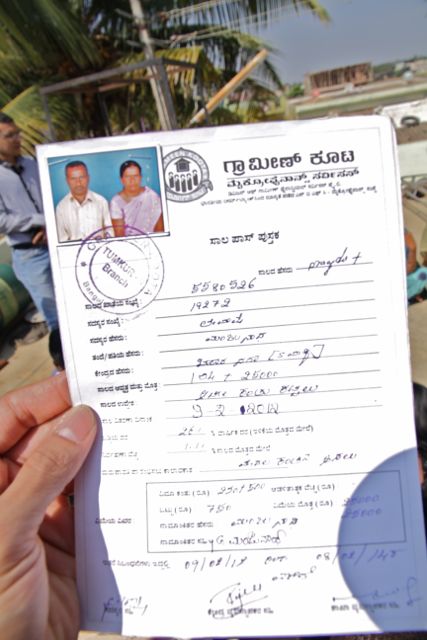 Family card - print from Mifos |  Loan schedule - print from Mifos | 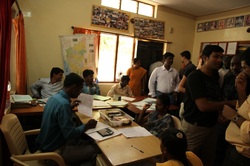 12:00-1:00 - GK branch visit
> There were fairly substantial wads of money lying in the open that the branch manager was individually counting and handing out the loans. An atmosphere of trust and familiarity was palpable
> We found a throng of people sitting outside the branch. We enquired to find, they have all been intimated with a ticket/token number, that their loans have been granted, and are awaiting disbursal for half a day
> We got to know how the loan approval(MFI submits to Credit bureau (CRA like SIBIL, Equifax, HighMark) and disbursement works, and why that may take couple of weeks. That probably explained the crowd gathered outside that were spending a good part of the day sitting idly while they could be earning their $2. Though the MFI officers were doing their best, the process may have more scope to streamline -
Data sent offline --->Then there is check with other MFIs to see if the same party has other loans (total exposure) ---> There is a waiting period to ensure there isn't a parallel application ---> loan approved ---> data sent offline ---> the system has some checks ---> The Client is sent word ---> Client lands up ---> If the system checks are all complete by then, the client gets the money).
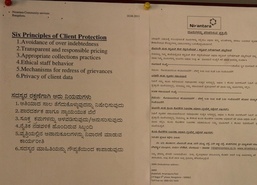 Six principles of (MFI) client protection 1:30-2:30 Nirantara regional office
> A house that doubles up as the office, with couple of furniture and cabinets thrown in
> These guys have a great motto (see picture)
The future of Mifos (through our looking glass)
The problem...
1. Micro Finance has received a good pinch of reality since its heydays, causing a glut in contributions from the developer community. While there has been a sobering realization in the developmental world that the backlash as probably extreme and there are definite and comparable benefits to giving the poor better access to financial products, this hasn't yet seen a revival in tech support.
...the opportunity
1. If we we get interested in this space, this probably gives us a chance to get back to contributing to it
The problem...
2. COSM is probably resource constrained leaving a mammoth platform in the hands of insufficient experience and resources
...the opportunity
2. With a clean slate one should stand a good chance of effecting a lot of beneficial influence
The problem...
3. The current platform is obsolete and the design/architecture/roadmap of the new platform is in its infancy
...the opportunity
3. One has a chance to architect the new platform to be much better than the past one
 ConclusionMicro finance has surely come a long way since Muhammad Yunus conceived it and institutionalized it more than thirty years ago. There are, now, a lot more organizations, funding, infrastructure, data, criticism and beneficiaries. This field has also matured as a business model, managing to accomodate professional parties that come together to create value profitably. It is probably on the verge of going past the hype cycle trough, and aims to get into a continuously useful phase. Yet, there is a lot left to be done (more than half the three billion Maries to be reached). A lot of scope for well-intentioned visionary zeal to innovate and discover greater value at the bottom of the pyramid!
 Below are couple of sample, real and typical job descriptions of business analysts, posted on career classifieds. What strikes you about these, at a casual glance? - 1. Sr. Business Analyst in a financial publishing house - " - Collaborate with internal and external customers, software engineers, etc. to interview, research, analyze, and derive business, functional, and non-functional requirements for products.
- Translate business requirements into detailed functional and non-functional specifications.
- Contribute, as required, to the "look" and "feel" of the product including screen design, on-line text, and/or graphical user interface (GUI) consistent with company standards.
- Participate in the design and testing phases, including design and testing of prototypes and orchestration and sign-off on acceptance test results to ensure design integrity"
2. A pure play IT Business analyst - "- Lead and facilitate the elaboration process for new system projects
- Analyze and design solution recommendations for system modifications/enhancement to meet the needs of the end users.
- Develop system requirement specifications for system projects and large strategic projects
- Act as an liaison between end users and IT departments
- Develop test plans and participate in system implementation of new or revised systems"
Do you see anything missing in the above? Of course, one could argue that the description is just as that particular firm wants it to be, and every firm has its own "right" role definition. Be that as may, and in general, even if one may say that the definition of a BA varies across the industry, are the descriptions still complete? Below is my mindmap of various areas that I think every Business Analyst needs to be looking at. The third level down (Brown) may be defined in context and specific to the prevalent practices, but are not the first two levels fairly generic? If a BA is not doing these, then can the resulting software product still be good? Consistently .
 BA skill inventory in IT
In my little experience and in all the books that I have read (have read most on Retrospectives), I always see retrospective as a one-time event. There are many types of these though - a sprint/iteration retro, or a release retro, program retro - you name it. Yet, though various in scope, they seem similar in structure - recounting experience for the duration that the retro covers. One uses various means to prepare the team, poll them for their thoughts, represent them in a visible information radiator and facilitate discussion. This is truly a great exercise that I have come to admire, that forms a wonderful feedback loop for the team.
Now, I have been trying to do this a little different recently - applying Systems thinking. How about, in the usual retro that you do, after collecting the various positive and negatives, you don't see them as individual issues but a chain of cause and effect. For every positive or negative, there is, if you seek into the audience another cause attributed - and soon you'd see an entire cycle emerge (Last build was slow - (why, because) - the CI pipeline has become large - (why, because) - the QA had suddely added a lot of tests - (why, because) - we hadn't added enough functional tests earlier - (why, because) etc etc.. you see then the entire retro starts to make sense.
What do you think?
In the past year, having gotten curious about academic research around organizational learning (in general Peter Senge's work, Harvard OD group and Society of Organizationl learning), I ended up coming acros Chris Argyris' work in each of the paths. Have been reading Reasons and Rationalizations & Flawed advise and management trap, since then. Not easy reads I admit. But the rewards were rich. The concepts on action science seemed to uncover all the defensive routines that organizations and people unknowingly fall into, that inhibit learning. Argyris' other concepts I came acorss: 1. Espoused theory and Theory in use - Model I and Model II2. Double loop, Deutero learning3. Ladder of inference / Right-hand-left-hand technique to uncover assumptions 4. Defensive routines: teaching smart people how to learn 5. Productive conversations/dialogue/Bohm - balancing enquiry and advocacy etc (more of Senge's work here) Since then, have been frantically looking around for proponents, courses and seminars on this topic. They seem few and far between (especially in India). With what little is at my disposal, am trying to put together some exercises, especially around Ladder of inference/RHLH dialogues, using the classic movie - 12 angry men. Would be great if we can share other similar methods, cases that illiustrate these concepts.
What <IS> the role of a Business Analyst
Business analysis, traditionally, has included among other things the following broad objectives -
1. Ensure client requirements are all captured
2. Ensure the developer understands it
3. Ensure the code meets the aforementioned requirements
There are different schools of thought on how these are performed. In general though, traditionally, analysis demanded these objectives be met through the following activities:
Objective: 1. Ensure client requirements are all captured
Activities:
a. Elicit requirements through Questionnaire, Workshops
b. Detailed documents or Use cases/diagrams to capture requirements
c. Traceability to ensure requirements don't get dropped
Objective 2. Ensure the developer understands it
Activities:
a. Capture system/data flows
b. Capture requirements as use cases/test cases
Objective: 3. Ensure the code meets the aforementioned requirementsActivities:
a. Perform and sign-off functional tests
What <SHOULD BE> the role of a Business Analyst
As the role evolved, especially in the Agile world (coincidentally not consequently, I think) , business analysis has also acquired the following objectives/activities, and dropped some of the above as a result:
Objective 4. Ensure the requirements are right
Activities:
a. User stories: Get close to the end-users, and think from their perspective and their goals - look at user value, not business value - hence ensure, the real requirements are captured -> This has received a whole new infusion of ideas from Human Computer Interaction/Cognitive and behavioural science -> this also meant use cases, which were still partly systemic rather than completely user-centric, became user stories. And then, user stories became better defined when BAs realized "users" should be real end-users, not the system. Thus, non-functional requirements became cross-functional requirement or just plain requirements worded differently to ensure the delivery team doesn't loose focus on how the user experiences it
b. Task Analysis/Story maps: We started looking at requirements as necessary to perform a user objective. This ensured we optimize software for the best user experience, and not just add better UI or throw better hardware to take care of it. More importantly it e
c. Get user feedback: Plan to release often, showcase and get continuous feedback
Objective 5. Maximize ROI
Activities
a. Identify MMF (Minimum marketable features) - Ensure requirements are not just prioritized, but packaged in such a way that value is realized at the earliest. And minimum time is spent on what is less valuable
b. Split stories/Release planning - create independent, negotiable, valuable, estimable, small and testable chunks of requirements that will flow through the development pipeline smoothly, and can beget immediate feedback
Finished reading a book that came recommended by the ThoughtWorks chief, Roy Singham: Happiness - lessons from a new science.
In an almagam of economics, cognitive science and pure common sense this book explains how Happiness is a possible and ideal co-operative equilibrium. Richly littered with credible research, Mr. Layard, strings together a credible argument for measuring progress and making policy goals, in terms of well-being, satisfaction and happiness. He also buries the archaic notion of a Smithsian wealth and prosperity, by proving that it inevitably leads to a hedonic tradmill, wherein everyone exhibits the proverbial football-crowd behaviour of trying to get a better view, but in the end just cause everyone else to stand up, thus neither having a better view nor a rested disposition
So I got thinking along the following lines,
- What is Happiness
- Why Happiness
- Are we getting happier
- What makes us happy
... and did a little presentation at a X-Conf Pune.
Bibliography
- Utilitarianism - John Stewart Mill
- Wealth of Nations - Adam Smith
- An Analysis of decision under risk - Daniel Kahnemann, Amos Tversky
|

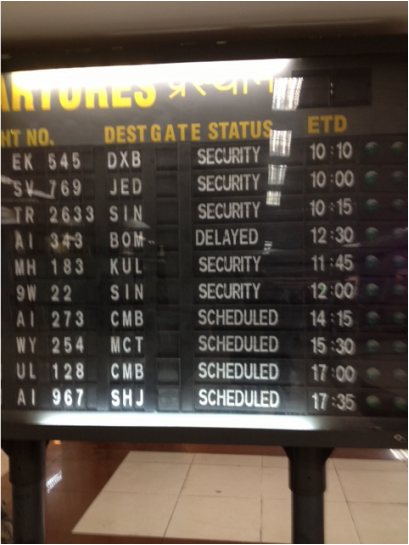

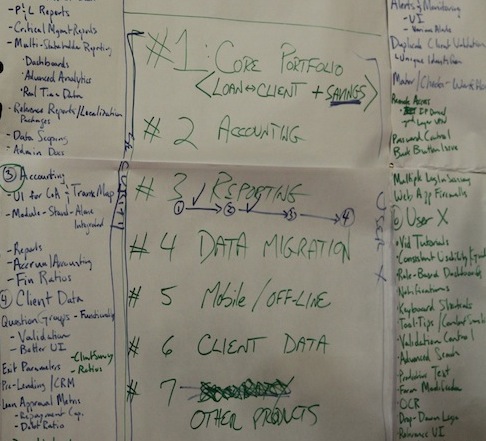











 RSS Feed
RSS Feed